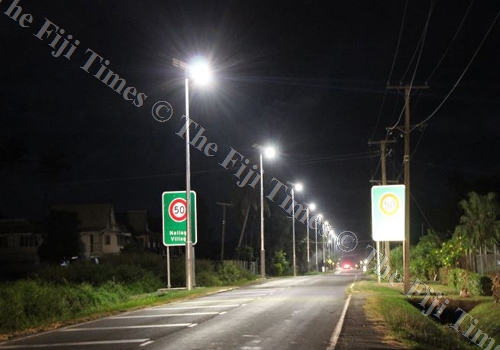Nailaga Village sits a few minutes outside the little township of Ba in Western Viti Levu.
The national highway cuts right through it. Humps are placed along the way, obviously to slow down traffic.
This is where the Fiji Roads Authority (FRA) has installed 25 solar streetlights.
They are lined up along the highway, a first for the village and for the country.
As FRA acting general manager electrical Musheer Khan said, Fiji was a new regional leader in the adaptation of sustainable energy solutions that would help protect and preserve the environment.
The 25 Orca Vertex solar lighting system for the village, he pointed out, was designed in Australia utilising the National Aeronautics and Space Administration’s (NASA) solar insolation data for Fiji. Importantly, it is customised to meet V5 street lighting standards, he said.
This standalone system, he said, has been specifically designed to provide up to 13 hours of operation with 56 hours (4 days) autonomy.
He said the Energy Management Control System has been set to operate the 25 60W LED street lights at 100 per cent from dusk till dawn.
The benefits, Mr Khan said, were immense.
When broken-down, annually, the 25 streetlights would use 6570kW hour of energy from the sun.
It would offset 3357kgs of carbon emission, save electricity generator diesel consumption by 1932 litres and was equivalent to planting 23 trees.
Sceptics may question whether the system, or new technology, would effectively compete against other energy sources.
Given the traditional weather in the division, especially in Ba, one would expect this system to be quite effective.
The challenge perhaps is how we can learn from this system and make it effective in as many of our urban centres as possible around the country.
Perhaps it should be used as an alternative or the major source of energy.
It actually does tie in well with our concerted effort to propel our presidency of COP23 to great heights.
These lights may be futuristic to some extent, brightening up Nailaga Village with energy from the sun, yet they could also be cost-effective, and perfectly fit into the campaign that raises issues of climate change.
The future actually looks quite bright for rural-based communities should this be a successful workable option.
Its effectiveness could stretch through to tie in with road safety issues for instance, brightening up villages and densely populated areas around the country. Understandably there would need to be discussions on how resources and finances are channelled forward to make this a viable option.
This is a major step forward though, and must be acknowledged.




